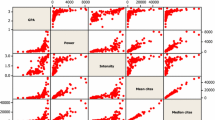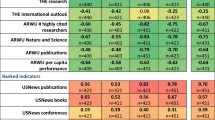Abstract
It is now generally accepted that institutions of higher education and research, largely publicly funded, need to be subjected to some benchmarking process or performance evaluation. Currently there are several international ranking exercises that rank institutions at the global level, using a variety of performance criteria such as research publication data, citations, awards and reputation surveys etc. In these ranking exercises, the data are combined in specified ways to create an index which is then used to rank the institutions. These lists are generally limited to the top 500–1000 institutions in the world. Further, some criteria (e.g., the Nobel Prize), used in some of the ranking exercises, are not relevant for the large number of institutions that are in the medium range. In this paper we propose a multidimensional ‘Quality–Quantity’ Composite Index for a group of institutions using bibliometric data, that can be used for ranking and for decision making or policy purposes at the national or regional level. The index is applied here to rank Central Universities in India. The ranks obtained compare well with those obtained with the h-index and partially with the size-dependent Leiden ranking and University Ranking by Academic Performance. A generalized model for the index using other variables and variable weights is proposed.





Similar content being viewed by others
Notes
No. of papers of an institution in top 1 % of cited papers, or HiCP, where cited papers includes only papers from the current set of institutions.
Journal Citation Reports-Thompson Reuters, https://jcr.incites.thomsonreuters.com/.
References
Academic Ranking of World Universities. (2011). Ranking methodology. Available at: www.arwu.org/ARWUMethodology2007.jsp. Accessed May 11, 2015.
Aguillo, I. F., Ortega, J. L., & Fernández, M. (2008). Webometric ranking of world universities: Introduction, methodology, and future developments. Higher Education in Europe, 33(2–3), 233–244.
Basu, A., & Aggarwal, R. (2001). International collaboration in science in India and its impact on institutional performance. Scientometrics, 52(3), 379–394.
Basu, A., Aggarwal, R., Kumar, D., Kathuria, G., Jha, S., & Rani, T. (2000). Scientific productivity…where do we stand? Second brief report on bibliometric indicators of Indianscience, NISTADS Report, January 2000.
Basu, A., & Nagpaul, P. S. (1998). National mapping of science. NISTADS Report # REP-248/98.
Billaut, J. C., Bouyssou, D., & Vincke, P. (2010). Should you believe in the Shanghai ranking? An MCDM view. Scientometrics, 84(1), 237–263.
Bornmann, L. (2013). How to analyze percentile impact data meaningfully in bibliometrics? The statistical analysis of distributions, percentile rank classes, and top-cited papers. Journal of the Association for Information Science and Technology, 64(3), 587–595.
Bornmann, L., Bowman, B. F., Bauer, J., Marx, W., Schier, H., & Palzenberger, M. (2014), Bibliometric standards for evaluating research institutes in the natural sciences. In B. Cronin, C. R. Sugimoto (Eds.), Beyond bibliometrics (pp. 201–224). Massachusetts Institute of Technology. ISBN: 978-0-262-525551-0.
Bornmann, L., & Marx, W. (2014). How to evaluate individual researchers working in the natural and life sciences meaningfully? A proposal of methods based on percentiles of citations. Scientometrics, 98(1), 487–509.
Bornmann, L., Moritz, S., Felix de Moya, A., & Rüdiger, M. (2014b). What is the effect of country-specific characteristics on the research performance of scientific institutions? Using multi-level statistical models to rank and map universities and research-focused institutions worldwide. Journal of Informetrics, 8(3), 581–593.
Bornmann, L., Moritz, S., Felix de Moya, A., & Rüdiger, M. (2015). Ranking and mapping of universities and research-focused institutions worldwide: The third release of excellencemapping.net. Collnet Journal of Scientometrics and Information Management, 9(1), 65–72.
Bradford, S. C. (1934). Sources of information on specific subjects. Engineering, 137, 85–86. Reprinted in 1985 in Journal of Information Science, 10(4), 173–180.
Costas, R., & Bordons, M. (2007). The h-index: Advantages, limitations and its relation with other bibliometric indicators at the micro level, Special Issue on h-index. Journal of Informetrics, 1(3), 193–203.
García, J. A., Rodriguez-Sánchez, R., Fdez-Valdivia, J., Torres-Salinas, D., & Herrera, F. (2012). Ranking of research output of universities on the basis of the multidimensional prestige of influential fields: Spanish universities as a case of study. Scientometrics, 93(3), 1081–1099.
Geraci, M., & Esposti, D. M. (2011). Where do Italian universities stand? An in depth statistical analysis of national and international rankings. Scientometrics, 87(3), 667–681.
Glänzel, W. (2001). National characteristics in international scientific co-authorship relations. Scientometrics, 51(1), 69–115.
Gupta, B. M. (2011). Indian S&T during 15 years (1996–2010): A quantitative assessment using publication data. DESIDOC Journal of Library and Information Technology, 31(5), 359–370.
Hirsch, J. E. (2005). An index to quantify an individual’s scientific research output. PNAS, 102(46), 16569–16572.
Huang, M.-H. (2012). Exploring the h-index at the institutional level: A practical application in world university rankings. Online Information Review, 36(4), 534–547.
Huang, M. H., & Chi, P. S. (2010). A comparative analysis of the application of h-index, g-index, and a-index in institutional-level research. Journal of Library and Information Studies, 8(2), 1–10.
Huang, M.-H., & Lin, C. S. (2011). Counting methods and university ranking by h-index, ASIST 2011, October 9–13, 2011, New Orleans, LA, USA.
Jeremic, V., Bulajic, M., Martic, M., & Radojicic, Z. (2011). A fresh approach to evaluating the academic ranking of world universities. Scientometrics, 87(3), 587–596.
Lazaridis, T. (2010). Ranking university departments using the mean h-index. Scientometrics, 82(2), 211–216.
Leydesdorff, L., & Opthof, T. (2010). Normalization, CWTS indicators, and the Leiden rankings: Differences in citation behavior at the level of fields. arXiv preprint arXiv:1003.3977.
Liu, N. C., & Cheng, Y. (2005). The Academic Ranking of World Universities. Higher Education in Europe, 30(2), 127–136.
Liu, N. C., Cheng, Y., & Liu, L. (2005). Academic ranking of world universities using scientometrics: A comment to the Fatal Attraction. Scientometrics, 64(1), 101–109.
Liu, N. C., & Liu, L. (2005). University rankings in China. Higher Education in Europe, 30(2), 217–227.
Matthews, A. P. (2012). South African universities in world rankings. Scientometrics, 92(3), 675–695.
Molinari, A., & Molinari, J. (2008). Mathematical aspects of a new criterion for ranking scientific institutions based on the h-index. Scientometrics, 75(2), 339–356.
National Institutional Ranking Framework, NIRF. (2015). A methodology for ranking of universities and colleges in India. Ministry of Human Resource Development, MHRD https://www.nirfindia.org/Docs/Ranking%20Framework%20for%20Universities%20and%20Colleges.pdf. Accessed January 2016.
Nishy, P., Panwar, Y., Prasad, S., Mandal, G., & Prathap, G. (2012). An impact-citations-exergy (iCX) trajectory analysis of leading research institutions in India. Scientometrics, 91(1), 245–251.
Singh, V. K., Uddin, A., & Pinto, D. (2015). Computer science research: The Top 100 institutions in India and in the world. Scientometrics, 104(2), 529–553.
Torres Salinas, D., Moreno-Torres, J. G., Delgado-Lopez-Cozar, E., & Herrera, F. (2011). A methodology for institution-field ranking based on a bi-dimensional analysis. Scientometrics, 88(3), 771–786.
Uddin, A., Bhoosreddy, J., Tiwari, M., & Singh, V. K. (2016). A sciento-text framework to characterize research strength of institutions at fine-grained thematic area level. Scientometrics, 106(3), 1135–1150.
Uddin, A., & Singh, V. K. (2015). A Quantity–Quality composite ranking of Indian Institutions in CS Research. IETE Technical Review, 32(4), 273–283.
UGC Note on Vacant Positions. (2014). http://www.ugc.ac.in/pdfnews/0342004_vacant-position-CU-as-on-01-01-2014.pdf. Accessed on June 18, 2014.
Van Raan, A. F. J. (2005). Fatal attraction: Conceptual and methodological problems in the ranking of universities by bibliometric methods. Scientometrics, 62(1), 133–143.
Vinkler, P. (2006). Composite scientometric indicators for evaluating publications of research institutes. Scientometrics, 68(3), 629–642.
Waltman, L., Calero-Medina, C., Kosten, J., Noyons, E. C. M., Tijssen, R. J. W., Van Eck, N. J., et al. (2012). The Leiden ranking 2011/2012: Data collection, indicators and interpretation. Journal of the American Society of Information Science and Technology, 63(12), 2419–2432.
Waltman, L., & Van Eck, N. J. (2012). A new methodology for constructing a publication level classification system of Science. Journal of the American Society of Information Science and Technology, 63(12), 2378–2392.
Waltman, L., Van Eck, N. J., Leeuwen, T. N., Visser, M. S., & Van Raan, A. F. J. (2011). Towards a new crown indicator: An empirical analysis. Scientometrics, 87(3), 467–481.
Acknowledgments
This work is supported by research grants from Department of Science and Technology, Government of India (Grant: INT/MEXICO/P-13/2012) and University Grants Commission of India [Grant: F. No. 41-624/2012(SR)].
Author information
Authors and Affiliations
Corresponding author
Ethics declarations
Conflict of interest
None.
Rights and permissions
About this article
Cite this article
Basu, A., Banshal, S.K., Singhal, K. et al. Designing a Composite Index for research performance evaluation at the national or regional level: ranking Central Universities in India. Scientometrics 107, 1171–1193 (2016). https://doi.org/10.1007/s11192-016-1935-0
Received:
Published:
Issue Date:
DOI: https://doi.org/10.1007/s11192-016-1935-0




